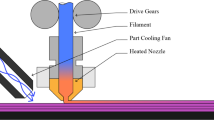Abstract
Extending fused filament fabrication process to feedstock materials used in metal injection molding could be a solution to produce the so-called green part. Nevertheless, process conditions could lead to low mechanical properties partly due to a lack of adhesion between the filament and the substrate. Thus, it is important to estimate correctly the temperature at the substrate interface induced by the filament deposition. Knowing that the extrusion printhead is a relative massive steel part moving at a small distance of the substrate, we have determined the radiative effect of nozzle passages on the temperature surface of the substrate. For that, we inserted thermocouples having a diameter of 0.25 mm under the substrate surface at a depth of 0.45 mm. Thermocouples measured an increase of temperature between 1.1 and 1.4 °C depending on the controlled nozzle and substrate temperatures. A 2D finite-difference model allows determining a significant increase of the substrate temperature at the surface varying between 3.5 and 5 °C depending on processing conditions. This increase of interface temperature, which is favorable to the adhesion of the filament to another one, can be advantageously considered.














Similar content being viewed by others
References
German RM (2019) Metal powder injection molding (MIM): key trends and markets. In: Heaney FD (ed) Handbook of metal injection molding, 2nd edn. Woodhead Publishing, Cambridge, pp 1–25
Gonzalez-Gutierrez J, Cano S, Schuschnigg S et al (2018) Additive manufacturing of metallic and ceramic components by the material extrusion of highly-filled polymers: a review and future perspectives. Materials 11:840
Rane K, Strano M (2019) A comprehensive review of extrusion-based additive manufacturing processes for rapid production of metallic and ceramic parts. Adv Manuf 7:155–173. https://doi.org/10.1007/s40436-019-00253-6
Regnier G, Le Corre S (2016) Modeling of thermoplastic welding. Heat transfer in polymer composite materials. Wiley ISTE Ltd, Hoboken, pp 235–268
Wool RP, O’Connor KM (1981) A theory of crack healing in polymers. J Appl Phys 52:5953–5963. https://doi.org/10.1063/1.328526
de Gennes PG (1971) Reptation of a polymer chain in the presence of fixed obstacles. J Chem Phys 55:572–579. https://doi.org/10.1063/1.1675789
Doi M, Edwards SF (1978) Dynamics of concentrated polymer systems. Part 1.—Brownian motion in the equilibrium state. J Chem Soc 74:1789–1801
Yang F, Pitchumani R (2002) Healing of thermoplastic polymers at an interface under nonisothermal conditions. Macromolecules 35:3213–3224. https://doi.org/10.1021/ma010858o
Partain SC (2007) fused deposition modeling with localized pre-deposition heating using forced air. Master thesis, Montana State University
Striemann P, Hülsbusch D, Niedermeier M, Walther F (2020) Optimization and quality evaluation of the interlayer bonding performance of additively manufactured polymer structures. Polymers 12:1166. https://doi.org/10.3390/polym12051166
Ravi AK, Deshpande A, Hsu KH (2016) An in-process laser localized pre-deposition heating approach to inter-layer bond strengthening in extrusion based polymer additive manufacturing. J Manuf Process 24:179–185. https://doi.org/10.1016/j.jmapro.2016.08.007
Deshpande A, Ravi A, Kusel S et al (2019) Interlayer thermal history modification for interface strength in fused filament fabricated parts. Prog Addit Manuf 4:63–70. https://doi.org/10.1007/s40964-018-0063-1
Seppala JE, Migler KD (2016) Infrared thermography of welding zones produced by polymer extrusion additive manufacturing. Addit Manuf 12:71–76. https://doi.org/10.1016/j.addma.2016.06.007
Lepoivre A, Boyard N, Levy A, Sobotka V (2020) Heat transfer and adhesion study for the FFF additive manufacturing process. In: Bambach M (ed) Procedia manufacturing. Elsevier, Amsterdam, pp 948–955
Xu D, Zhang Y, Pigeonneau F (2021) Thermal analysis of the fused filament fabrication printing process: experimental and numerical investigations. Int J Mater Form 14:763–776. https://doi.org/10.1007/s12289-020-01591-8
Wolszczak P, Lygas K, Paszko M, Wach RA (2018) Heat distribution in material during fused deposition modelling. Rapid Prototyp J 24:615–622. https://doi.org/10.1108/RPJ-04-2017-0062
Cosson B, Asséko ACA (2019) Effect of the nozzle radiation on the fused filament fabrication process: three-dimensional numerical simulations and experimental investigation. J Heat Transfer 141:082102. https://doi.org/10.1115/1.4043674
Bedoui F, Fayolle B (2014) POM mechanical properties. In: Lüftl S, Visakh PM, Chandran S (eds) Handbook od polyoxymethylene. Wiley, Hoboken, pp 241–255. https://doi.org/10.1002/9781118914458.ch9
Kowalski L, Duszczyk J, Katgerman L (1999) Thermal conductivity of metal powder-polymer feedstock for powder injection moulding. J Mater Sci 34:1–5. https://doi.org/10.1023/A:1004424401427
Pearce JV, Montag V, Lowe D, Dong W (2011) Melting temperature of high-temperature fixed points for thermocouple calibrations. Int J Thermophys 32:463–470. https://doi.org/10.1007/s10765-010-0892-8
Rodriguez JF, Thomas JP, Renaud JE (2000) Characterization of the mesostructure of fused-deposition acrylonitrile-butadiene-styrene materials. Rapid Prototyp J 6:175–186. https://doi.org/10.1108/13552540010337056
Bellehumeur C, Li L, Sun Q, Gu P (2004) Modeling of bond formation between polymer filaments in the fused deposition modeling process. J Manuf Process 6:170–178. https://doi.org/10.1016/S1526-6125(04)70071-7
Delaunay D, Le Bot P, Fulchiron R et al (2000) Nature of contact between polymer and mold in injection molding. Part I: influence of a non-perfect thermal contact. Polym Eng Sci 40:1682–1691. https://doi.org/10.1002/pen.11300
Acknowledgements
The authors wish to acknowledge the Association Nationale Recherche Technologie (ANRT), France, based on the decision number 2018/1168 and Safran Group for funding this research work and our colleague Prof. Francisco Chinesta for the enriching discussions and the advices for the thermal modelling.
Funding
This study was funded by the Association Nationale Recherche Technologie (France), based on the decision number 2018/1168, and Safran Group.
Author information
Authors and Affiliations
Corresponding author
Ethics declarations
Conflict of interest
All the authors declare that they have no conflict of interest.
Additional information
Publisher's note
Springer Nature remains neutral with regard to jurisdictional claims in published maps and institutional affiliations.
Rights and permissions
About this article
Cite this article
Thézé, A., Régnier, G., Guinault, A. et al. Fused filament fabrication printing process of polymers highly filled with metallic powder: a significant influence of the nozzle radiation on the substrate temperature. Int J Mater Form 14, 1511–1521 (2021). https://doi.org/10.1007/s12289-021-01645-5
Received:
Accepted:
Published:
Issue Date:
DOI: https://doi.org/10.1007/s12289-021-01645-5




